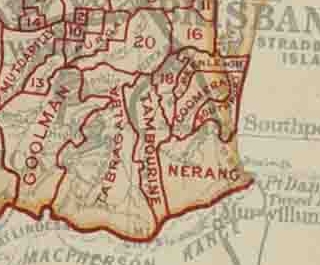1854 to 1870


James Henderson came to ‘Tabragalba’ in 1854 taking up a partnership with Dugald Graham. Graham later sold his share to James Henderson and went up to the Central Burnett District.
On 6 June 1859, Queen Victoria signed the Letters Patent, authorising Queensland’s separation from NSW confirming its status as an independent colony (known as Qld Day). Land Laws pertaining to settlement were passed including the ‘Alien Of Crowns Land’ Act resuming about half of the Squatters Runs in terms of Depasturing Licences.
In the early 1860’s Duckett White took up Beau Desert. In 1862 Hugh Mahoney and his son Thomas followed the ‘Caningera Creek’ down to what is now known as Irvings-Ford. They started to fell the cedar and began logging in the adjacent pockets and at Lawyer Cane Flat. An interesting article in the Trove Newspaper states “the red cedar men worked in the valley for about two years, chopping and dropping all of the fallen timber that lay across the creek, so that there should be a clear run when the floods came. In 1869 a very big flood In the creek brought the logs down in hundreds, forming the biggest timber jam ever seen in the creek. Logs in hundreds were hauled out on the Tabragalba side, and covered a little flat on what is now C. Reiser’s property.”
In about 1862, William Steele built a home called ‘Albert Park’ on the northern bank of the Albert River where he grew cotton and sugar cane for a while. (It is noted that Tamborine Creek was renamed ‘Steele Creek’, a small falls in the river is called ‘Steele Falls’ and a road leading past the cemetery was called ‘Steele Road’.)
The first vessel to be financed by the Irish Immigration Committee, the ‘Erin-Go-Brach’ arrived in Brisbane in 1862, carrying Anthony Flanagan (who moved to a property in Tambourine known as ‘Flanagan’s Corner’ on the road to the mountain), James Ryan and family, Patrick Cusack and family, Simon Corcoran, and William Rafter. As well in 1862, Patrick Eagan arrived aboard ‘The City Of Brisbane’ and William Walsh arrived on the ‘Prince Consort’ which underwent mutiny.
Thomas Plunkett along with Michael Yore arrived in Queensland aboard the ‘Fiery Star’ in 1863. They formed a long friendship and moved to Dairy Creek. Initially, although, they both went to the Gympie gold fields to try their hand and it was here that they met William Walsh.
The ‘Tamboureen’ property was sold in 1864 to Captain Charles Williams, (who may have become a ‘timber-getter’ at Cedar Creek according to a Logan River Historical document). At that time communication between Tambourine and Mundoolan was by a bridle track, where on the Tambourine side, the track was narrow and deep, and it was known that the “un-wary rider would be fortunate if he escaped a drenching in the water at that point of the Albert River”. Recorded on the same historical document from the Scenic Rim Library (but not found on historical Squatters Runs), around 1865, William Tooth, (with family ties to Sydney Kent Brewery), apparently purchased a portion of the Tambourine Station. After settling in Logan Reserve for several years, James Ryan with his wife, four daughters and three sons settled on the south bank of Albert River in Tambourine in 1865.
After leaving Tabragalba around 1867, James Henderson built a home on the northern bank of Albert River named ‘Kinghorn’. In 1869, William Walsh procured 100 acres near Albert River at Tambourine which became known as Munster Vale. He devoted his landholding to grazing, dairying and cultivation, and was the first in the district to use a plough. After his wife Catherine Ryan died in 1876, he married Margaret Yore and had 8 children. Catherine Ryan’s sister, Ann, married Michael Yore, and her second sister, Maria Ryan, married Thomas Plunkett and her youngest sister maaied CB Beetham of Beaudesert. William was a member on the Tabragalba Divisional Board (part of which later became the Beaudesert Divisional Board) and the first Chairman of the Tamborine Divisional Board in 1890, prominent in the Shire Council from 1903.
In the same period of time from 1869, Thomas Plunkett selected land on the north bank of the Albert River at the Yarrabilba site stretching to the current northern boundary south to the Albert River. He built a residence called ‘Villa Maria’ on other side of Clutha Creek for his eight children named in honour of his wife Mary. Michael Yore secured property on the south bank of the Albert River. (The original property was known as ‘Argyle’ according to the electoral rolls of the late 1860s but origins unclear as not found anywhere else.)
Tambourine Station once more changed ownership, passing into the hands of the Joseph Henry Delpratt in 1870. A gentleman of French nationality, he hailed from the Isle of Jersey and arrived in Queensland in 1860. JH Delpratt obtained experience as a jackaroo on Beaudesert Station for five years, before returning to England where he obtained and resigned a commission with the West India regiment. He later returned to Queensland and purchased Tambourine Station. He began breeding high quality heavy draught horses, and purebred Shorthorn cattle, making his first purchase of female cattle from the Cressbrook herd.
